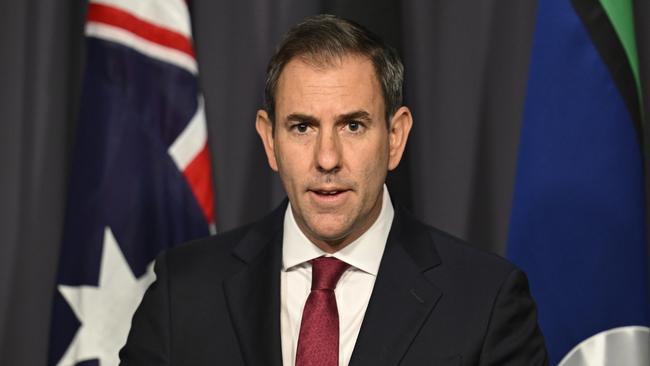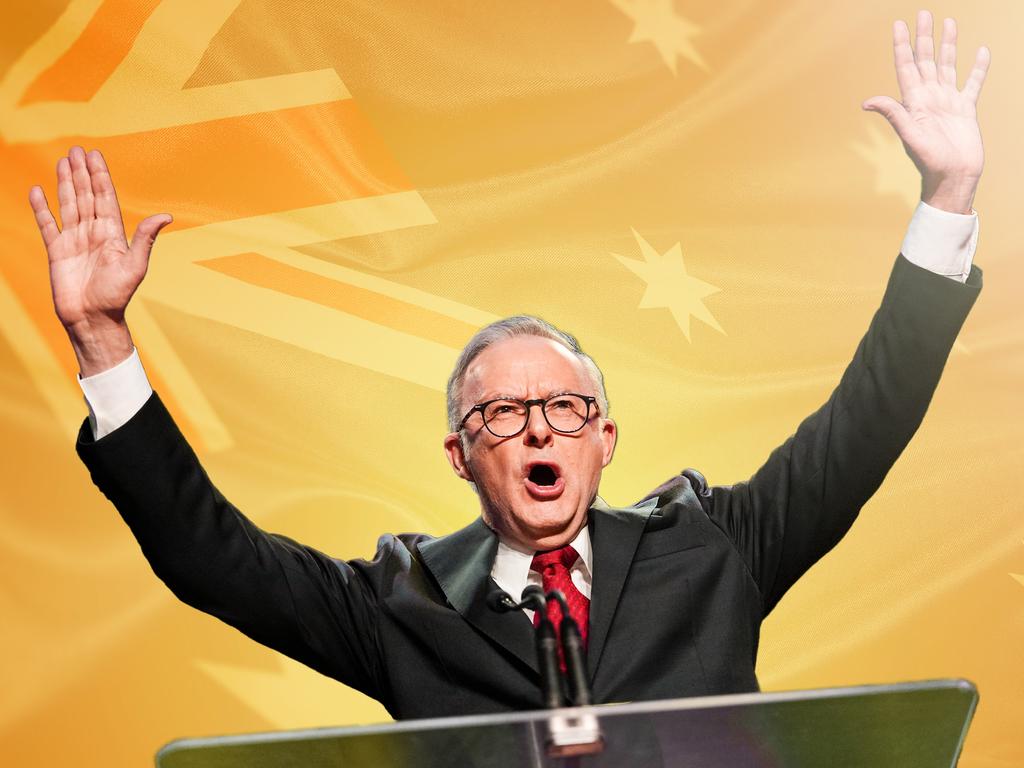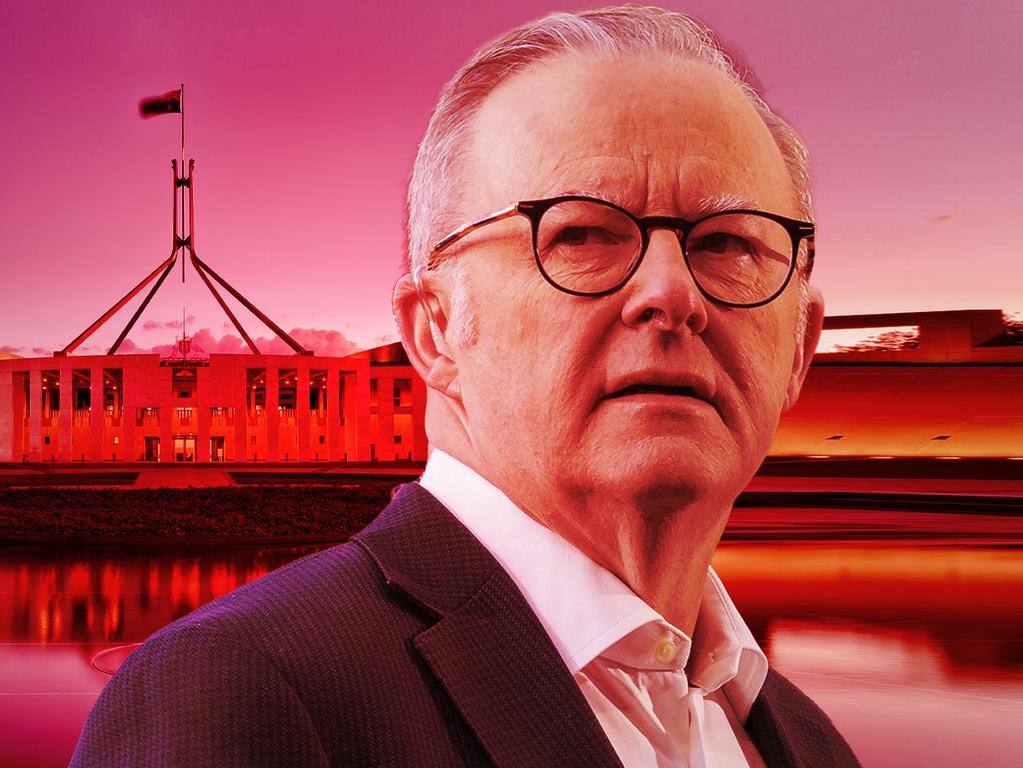Australia desperately needs more investment to raise productivity growth
As our economy meanders amid Trump’s global trade trauma, the long-running capital strike by corporate Australia is hurting everyone.

Jim Chalmers rolled out fresh briefing notes, jumped on the airwaves and did his best this week to Mr Sheen another lacklustre set of national accounts. While the local economy is in a funk, it still has a faint pulse despite Donald Trump’s helter-skelter trade war on everyone that is shredding the nerves of allies, enemies, shoppers and investors.
Buoyed by Anthony Albanese’s decisive election victory five weeks ago – Labor has won 94 lower house seats to the Coalition’s 43 – the Treasurer is settling into a new narrative where the private sector “steps up”, the public sector takes a “step back”, as Reserve Bank interest rate cuts bring consumers and capitalists back into driving the play.
Across the year to March the economy grew by 1.3 per cent, unchanged from the previous estimate for December. Extreme weather events have hurt exporters’ returns and families are saving more of their disposable income. On pretty much the best guess of every forecaster – private, public or international – Australia is limping along in the slow lane on borrowed money.
Even the latest estimate from the OECD this week pencils in 1.8 per cent growth this calendar year for us, an effective one-fifth downgrade on what the Treasury was expecting in the March budget, mainly due to a likely slowdown in global growth because of rising protectionism and uncertainty.
As the Paris-based think tank’s chief economist Alvaro Pereira put it in the latest OECD Economic Outlook: “Weakened economic prospects will be felt around the world, with almost no exception. Lower growth and less trade will hit incomes and slow job growth.”
Chalmers warns that “the world is a dangerous place” while insisting that for global investors “we’ve got a very compelling story to tell”.
“The economic story is a story of economic strength … that combination of lower inflation, very low unemployment, higher wages and incomes, interest rates coming down, debts coming down,” he told reporters on Wednesday. “We haven’t had a negative quarter of growth.”
On Labor’s watch, there has been uninterrupted growth in output but not so much of it to convince the public and investors it’s all tickety-boo. Since the September quarter in 2022, during a time of high borrowing rates, GDP has increased by 4 per cent while the population has grown by around 5.8 per cent. On this very broad measure, living standards have deteriorated.
EY chief economist Cherelle Murphy detects a “malaise that has set in across the business sector and among households”. As well, there are deeper issues at play, notably a long-term stagnation in business investment.
“Productivity growth was flat in the quarter and down over the year, with no evidence that Australia is making any progress in shifting the problem, which worsened in the immediate aftermath of the pandemic,” Murphy said.
“It is a warning sign that changed policy conditions are needed to boost the economy’s capacity and ability to cope with new challenges.”
The latest accounts reveal spending on machinery and equipment fell by 3.7 per cent in the year to March, while recent surveys of investment intentions show that companies are scaling back their expansion plans.
This is where we arrive at the nation’s soft underbelly: a vulnerability that sticks out for anyone with a lazy million, let alone billion, of hot foreign money. Even the federal custodian, incessantly sweet-talking the movers of footloose capital, has to concede the point. “Our economy is not productive enough,” he said after the GDP report.
Behind the decline, of course, are deliberate policy choices, such as the expansion in the care economy, which has been a drag on productivity growth. According to Commonwealth Bank economists, productivity in the market sector is up 3.1 per cent on its pre-pandemic level while across the economy it is slightly negative.
Labor has promised to make productivity a central part of its second-term agenda, along with budget repair and the transition to clean energy. In the words of the Productivity Commission, the Albanese government’s key adviser on reform, “more capital (the machines, equipment and other durable goods that are used as inputs in production) helps workers to produce more goods and services”.
As well as a lower corporate tax rate, the business lobbies have pushed for an economy-wide investment allowance to allow firms to deduct expenses on machinery, plant and equipment. Labor rejected the proposal, but has extended an instant asset write-off for another year.
Stephen Smith monitors investment intentions and the pipeline of work for Deloitte Access Economics. He argues that “if we want a more productive economy and for our workers to be able to compete globally in sectors where we’re not at the global frontier, investment in machinery and equipment must lift”.
The Deloitte partner tells Inquirer there’s constant attention in our economic debate on the Reserve Bank and monetary policy, as if lower rates can cure our ills, such as weak investment. “That focus can be misplaced,” he says. “We need more business investment and broad cultural change to lift our productivity.”

Since the 2008-09 global financial crisis put a dose of salts through international finance, business investment hasn’t been the same. Sure, there was a boom in engineering construction in the mining industry in the early 2010s, when private investment peaked at 18 per cent of GDP. But otherwise there has been a long-running national capital strike.
In the decade before the GFC, private sector spending on machinery and equipment, precisely the things that raise worker productivity, habitually ran at 7-8 per cent of the economy. For the past decade it has languished at around 4 per cent of GDP.
In its outlook, the OECD found that despite historically low financing costs and strong corporate profitability since the GFC, investment has been weak. Subdued growth and elevated uncertainty explain about half the story. Then there’s a structural shift in investment, with companies spending more on digital assets, such as software, data, computing hardware, and research and development.
As well, firms have channelled a lower share of profits and borrowed funds into investment, while requiring persistently high rates of return, or “hurdle rates”.
“These trends may be associated with underlying forces that restrain business investment and dynamism, including declining competitive pressures and the challenges in financing intangible investments,” the outlook said.
In its analysis, the OECD draws attention to Australia’s poor investment performance. Based on what it calls a “simple accelerator model”, which predicts likely business investment based on changes in economic growth, the analysis estimates that since the GFC Australia has an “investment gap” of 30 per cent. For 17 OECD countries in the sample, the average gap was 17 per cent.

There are a host of possible reasons for this private capital frailty. Strong public works spending in transport infrastructure may be “crowding out” private enterprise; companies may simply be holding cash, engaging in share buybacks and returning profits to shareholders; our foreign investment regime is judged to be very restrictive compared with rich country peers.
More research is coming to the fore on this failure, and the government is busier on this front, but for too long there also has been a lack of competitive pressure in our economy, especially in key network services such as energy, transport, finance and construction. Many of the biggest names in business can run a tidy operation, clipping tickets in naturally protected or heavily regulated industries, making decent profits through price mark-ups without the need for retooling, more capacity or a disruptive refresh.
As the Productivity Commission warned last week, if the long-term low rate of investment persists, “it may contribute to a longer-term productivity slowdown in Australia”. We should all be stressed about that because across the long haul productivity growth has been responsible for 80 per cent of the rise in our material living standards.
“Productivity growth had been stagnant in Australia for the five years leading to the pandemic, and the 2010s produced the lowest decade of productivity growth since the 1960s,” the commission said in a research report. “We need to address the long-term drivers of the decline, such as the long-term decline in investment and business dynamism, and improving the diffusion of ideas and innovation to move all firms closer to the productivity frontier.”
Decoded, we are not match fit for these chaotic times; we need to be adept with the emerging general purpose technology of AI, while making it easier for young firms to flourish (or old ones to fail), cutting red tape for housing and energy project approvals, and getting capital and labour to their most productive uses.
The federal custodian is expert at rattling off a list of bite-sized measures that are in the works, including a national productivity fund to entice the states to get rid of unhelpful policies, competition reforms, improved foreign investment screening and a five-pillar review of the foundations of future prosperity. On tax? At best, wait and see.
Deloitte’s Smith argues the government alone cannot solve Australia’s productivity problem. “Business also has to be willing to reignite its sense of entrepreneurialism and innovation to invest in state-of-the-art technology, skills and new markets,” he says.
“We need both government and business to come to the party. Australia is not a particularly attractive place for global capital.
“We are relatively high taxing and, while some sectors are doing well and at the frontier of innovation, there are lots of areas where we are a middling country. While we’re relatively stable, our economy is not necessarily dynamic or high growth and we’re not as competitive as we could be.”
In a trading world at the mercy of the merciless American Don, we all need to bring our A-game.






